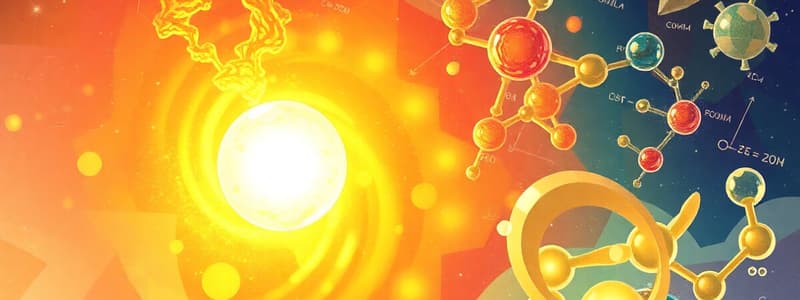Podcast
Questions and Answers
How many grams are in 4 moles of water (H₂O)?
How many grams are in 4 moles of water (H₂O)?
- 36.08 g
- 54.06 g
- 72.12 g (correct)
- 76.08 g
What calculation would you perform to find the number of moles from 150 grams of glucose (C₆H₁₂O₆)?
What calculation would you perform to find the number of moles from 150 grams of glucose (C₆H₁₂O₆)?
- 150 g ÷ 180.18 g/mol (correct)
- 150 g × 180.18 g/mol
- 150 g + 180.18 g/mol
- 180.18 g/mol ÷ 150 g
For a substance with a molar mass of 10 g/mol, what is the mass of 5 moles of this substance?
For a substance with a molar mass of 10 g/mol, what is the mass of 5 moles of this substance?
- 15 g
- 10 g
- 50 g (correct)
- 5 g
Flashcards are hidden until you start studying
Study Notes
Molar Mass and Mole Concept: Mole-to-Gram Conversions
-
Mole Definition:
- A mole is a unit of measurement in chemistry that represents 6.022 × 10²³ particles (Avogadro's number) of a substance.
-
Molar Mass:
- The mass of one mole of a substance, typically expressed in grams per mole (g/mol).
- Equal to the substance's atomic or molecular weight in atomic mass units (amu).
-
Conversion Formula:
- To convert moles to grams:
[ \text{Mass (g)} = \text{Number of moles} \times \text{Molar mass (g/mol)} ] - To convert grams to moles:
[ \text{Number of moles} = \frac{\text{Mass (g)}}{\text{Molar mass (g/mol)}} ]
- To convert moles to grams:
-
Steps for Mole-to-Gram Conversions:
- Identify the substance: Know the chemical formula to determine the molar mass.
- Calculate molar mass:
- For molecules, sum the atomic masses of all atoms in the formula.
- Use the periodic table for atomic masses.
- Use the conversion formula:
- Multiply the number of moles by the molar mass to find the mass in grams.
-
Example Calculation:
- For water (H₂O), molar mass = 2(1.01 g/mol) + 16.00 g/mol = 18.02 g/mol.
- If you have 3 moles of water:
[ \text{Mass} = 3 \text{ moles} \times 18.02 \text{ g/mol} = 54.06 \text{ g} ]
-
Common Errors to Avoid:
- Mixing up grams and moles.
- Incorrect molar mass calculations.
- Neglecting to use the correct number of significant figures.
-
Practice Problems:
- Calculate the mass of 2 moles of sodium chloride (NaCl).
- Determine how many moles are in 100 grams of glucose (C₆H₁₂O₆).
By understanding the mole concept and mastering mole-to-gram conversions, you can effectively quantify substances in chemical reactions and laboratory settings.
Mole and Molar Mass
- A mole represents 6.022 × 10²³ particles, known as Avogadro's number.
- Molar mass indicates the mass of one mole of a substance, measured in grams per mole (g/mol).
- The molar mass equals the atomic or molecular weight of a substance in atomic mass units (amu).
Conversion Formulas
- To convert moles to grams:
- Mass (g) = Number of moles × Molar mass (g/mol)
- To convert grams to moles:
- Number of moles = Mass (g) ÷ Molar mass (g/mol)
Steps for Mole-to-Gram Conversions
- Identify the Substance: Recognize the chemical formula necessary for determining molar mass.
- Calculate Molar Mass:
- For molecules, add together the atomic masses of all atoms in the chemical formula.
- Refer to the periodic table for accurate atomic mass values.
- Use the Conversion Formula:
- Multiply the number of moles by the molar mass to find the corresponding mass in grams.
Example Calculation
- For water (H₂O), calculate molar mass:
- ( \text{Molar mass} = 2(1.01 \text{ g/mol}) + 16.00 \text{ g/mol} = 18.02 \text{ g/mol} )
- If 3 moles of water are present:
- ( \text{Mass} = 3 \text{ moles} \times 18.02 \text{ g/mol} = 54.06 \text{ g} )
Common Errors to Avoid
- Confusing grams and moles in calculations.
- Failing to calculate the correct molar mass.
- Ignoring significant figures in measurements or calculations.
Practice Problems
- Calculate the mass of 2 moles of sodium chloride (NaCl).
- Determine the number of moles in 100 grams of glucose (C₆H₁₂O₆).
Importance of the Mole Concept
- Mastery of mole-to-gram conversions is crucial for quantifying substances in chemical reactions and laboratory experiments.
Studying That Suits You
Use AI to generate personalized quizzes and flashcards to suit your learning preferences.




